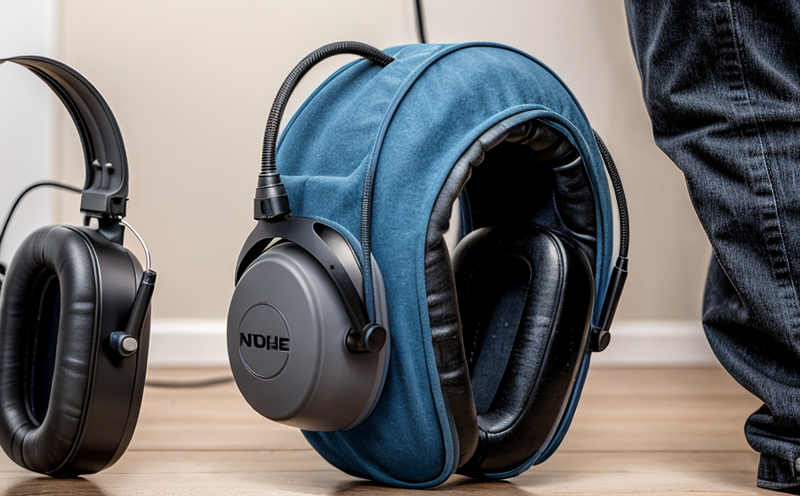ASTM E2235 Hearing Protector Attenuation Testing
The ASTM E2235 standard provides a method to determine the noise attenuation provided by hearing protectors. This test is crucial for ensuring that personal protective equipment (PPE) effectively reduces exposure to hazardous noise levels, thus protecting workers from auditory damage and other associated risks in high-risk industries.
ASTM E2235 specifies procedures for measuring the amount of noise reduction offered by a hearing protector when worn over the ear or behind the ear. The test involves placing the protector on an anthropomorphic dummy head that simulates human ear canal geometry, and then subjecting it to specified sound pressure levels from a calibrated noise source.
The testing apparatus includes a sound field system with a carefully designed configuration of loudspeakers. This setup ensures accurate measurement of attenuation at various frequencies over a broad range. The anthropomorphic dummy head is equipped with microphones simulating the ear canal, which record both the ambient noise and the noise reduced by the hearing protector.
The test procedure typically involves multiple steps to ensure accuracy and reliability:
- Calibration of the sound field system
- Placement of the anthropomorphic dummy head in a specified position
- Application of the hearing protector according to manufacturer specifications
- Exposure to pre-determined sound pressure levels
- Recording noise attenuation values for different frequencies
The resulting data is analyzed to calculate the average noise reduction provided by the protector. This value helps manufacturers and end-users understand the protector's performance under controlled laboratory conditions, which can then be used to inform decisions regarding workplace safety.
Real-world applications of ASTM E2235 include:
- Evaluating new hearing protectors for compliance with regulatory standards
- Testing prototypes during research and development phases
- Verifying the consistency of mass-produced items against design specifications
- Determining appropriate protection levels in various industrial environments
The test's accuracy is paramount because it directly impacts worker safety. By adhering strictly to ASTM E2235, laboratories ensure that their results are valid and reproducible.
Understanding the nuances of this standard also aids quality managers and compliance officers in ensuring that their facilities meet regulatory requirements and operational standards. R&D engineers benefit from detailed knowledge of testing protocols, allowing them to innovate and improve hearing protector designs effectively.
Applied Standards
The ASTM E2235 standard is widely recognized for its rigorous approach to measuring noise attenuation in hearing protectors. It aligns with other international standards such as ISO 1999-7, which also provides guidelines for similar tests but focuses more on the overall protection factor.
ASTM E2235 specifically targets industrial environments where noise levels may exceed safe exposure limits. By ensuring that hearing protectors meet this standard, industries can comply with OSHA and other regulatory bodies' requirements for protecting workers from excessive noise exposure.
The standard covers both over-the-ear (OTR) and behind-the-ear (BTE) hearing protectors, making it versatile enough to address a wide range of industrial needs. It also provides detailed instructions on how to perform the test accurately, ensuring consistent results across different laboratories and testing facilities.
Why Choose This Test
Selecting ASTM E2235 for hearing protector attenuation testing offers several advantages that are crucial for maintaining high standards of occupational safety:
- Regulatory Compliance: Meeting this standard ensures compliance with relevant regulations and guidelines, enhancing the reputation of your organization.
- Consistent Results: The standardized procedure guarantees consistent results across multiple tests, facilitating reliable quality control.
- Innovation Support: By adhering to ASTM E2235, R&D teams can validate their innovations and improvements in hearing protector technology, leading to better products.
- Worker Protection: Ensuring that protectors perform as expected under controlled conditions directly contributes to worker safety.
The test's precision is particularly important for industries with high noise levels, such as manufacturing plants, construction sites, and mining operations. By choosing ASTM E2235, these organizations can implement effective hearing protection strategies, reducing the risk of hearing loss among employees.
For procurement departments, selecting suppliers who adhere to this standard ensures that they are sourcing products from reputable manufacturers committed to quality and safety.
International Acceptance and Recognition
The ASTM E2235 standard is widely recognized internationally for its comprehensive approach to evaluating hearing protector attenuation. It has been adopted by numerous countries, including the United States, Canada, Europe, and Asia, due to its reliability and accuracy.
Countries like Australia, New Zealand, and parts of Africa have also incorporated aspects of ASTM E2235 into their national standards for occupational safety. This global acceptance underscores the importance of this standard in ensuring consistent quality across different regions.
Organizations that comply with ASTM E2235 benefit from enhanced credibility among international partners and clients, as it demonstrates a commitment to high standards of occupational health and safety. In competitive markets, compliance with internationally recognized standards like ASTM E2235 can be a decisive factor in gaining a competitive edge.





